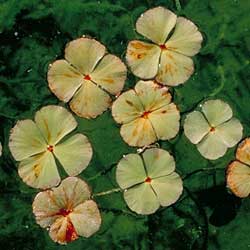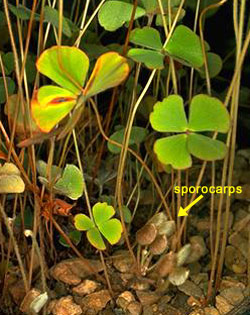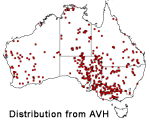Marsilea drummondii
 |
 |
 In place of the clusters of spore capsules on the back of a normal fern frond, Marsilea produces special structures called sporocarps, and the spores are produced in these. |
Common Nardoo
The aquatic fern genus Marsilea dominates the family Marsileaceae, holding 60 of the 67 species worldwide. M. drummondii, Common Nardoo, is one of the six Marsilea species endemic to Australia, and is found across every mainland state and territory (except in the ACT). It is an aquatic fern that prefers slow moving or still water, with fronds producing leaflets in the shape of four-leaf clovers, generally floating on the water’s surface.
 The
wide distribution of an aquatic fern in arid regions of Australia seems counter-intuitive.
However, Common Nardoo is highly adapted to the desert environment of Australia,
with spore production and germination triggered by variations in moisture to
capitalise on infrequent rain and floods. As the waters recede, spores are produced
in protective capsules, falling down the cracks of the drying mud where they
can remain viable for 20-30 years.
The
wide distribution of an aquatic fern in arid regions of Australia seems counter-intuitive.
However, Common Nardoo is highly adapted to the desert environment of Australia,
with spore production and germination triggered by variations in moisture to
capitalise on infrequent rain and floods. As the waters recede, spores are produced
in protective capsules, falling down the cracks of the drying mud where they
can remain viable for 20-30 years.
Within the genus Marsilea, M. drummondii can be identified by the spore capsule structure: the sporocarp. As a rule, the sporocarp stalk or pedicel (10-50mm long) is longer than the capsule or conceptacle itself (4-9mm long). Beyond use as an identifier, these spore capsules hold a place in Australian history. In times of food scarcity, the Aborigines ground the dry score capsules of M. drummondii to produce flour for baking. This preparation is essential for safe consumption, as parts of M. drummondii contain high levels of the enzyme Thiaminase. This enzyme induces Thiamin (Vitamin B1) deficiency or Beri-Beri in humans and livestock. Perhaps the most famous casualties were the explorers Burke and Wills in 1861. Ironically, whilst Burke and Wills died of Beri-Beri, another member of their expedition, King, survived on the ‘nardoo cakes’ made for him by the local Aborigines.
In the home garden pond, Common Nardoo grows as a perennial. It is hardy, thriving in a full sun to a semi-shade gradient, withstanding Canberra frosts and regenerating quickly from stresses. Transplant from the pond into a pot to allow propagation and algal treatment. A loam should be used with a gravel surface mulch to reduce leaching of nutrients into the pond. To propagate, remove the plant from the pot and divide into new plants by slicing through the ‘root ball’ with a knife or secateurs. M. drummondii is sensitive to algaecide, so separate treatment in a bucket at ¼ recommended dosage is advisable. Monitor to ensure algal death but fern survival.
Common Nardoo attracts frogs to the garden, providing good breeding habitat. To protect pond organisms, avoid usage of chemical sprays in combating pests such as aphids. Instead, hose these off with a solid spray of water – they will drown and become food for tadpoles and other invertebrates.
M. drummondii displays vigorous growth, yet does not compete with other water plants such as water lilies or milfoil – an ideal water plant when establishing a garden pond. Attractive foliage, vigorous growth and an interesting history make Marsilea drummondii, an excellent feature for the home water garden.
Text by Naomi Brydon (2004 Student Botanical Intern)
Derivation of the name: Marsilea drummondiiMarsilea – in honour of the Italian botanist, Count Luigi Ferdinando Marsigli (1656-1730), founder of the Bologna Academy of Arts and Institute of Sciences. drummondii – assumingly in honour of James Drummond, one of two brothers who collected for Messrs Veitch, the curator of Cork botanic garden from 1809 to 1829. James collected in Western Australia, whilst his brother, Thomas, collected in North America. |
References:
Aston, H.I. (1973) Aquatic Plants of Australia. Carlton: Melbourne University Press.
Chick, B.F., Quinn, C. & McCleary, B.V. (1985) ‘Pteridophyte Intoxication of Livestock in Australia’. In A.A. Seawright’s (Ed.) Plant Toxicology: Proceedings of the Australia – USA Poisonous Plants Symposium, Brisbane, Australia. May 14-18, 1984. Yeerongpilly: Queensland Department of Primary Industries.
Cribb, A.B. & J.W. (1990) Wild Food in Australia. Collins / Angus & Robertson Publishers.
Jones, D.L. (1998) ‘Marsileaceae’ in Anthony E. Orchard’s and Patrick M. McCarthy’s (eds.) Flora of Australia Vol. 48: Ferns, Gymnosperms and Allied Groups. CSIRO Publishing.
![An Australian Government Initiative [logo]](/images/austgovt_brown_90px.gif)

